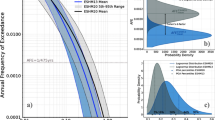Abstract
It is often assumed in probabilistic seismic hazard analysis that the magnitude distribution has an upper limit M max, which indicates a limitation on event size in specific seismogeneic conditions. Accurate estimation of M max from an earthquake catalog is a matter of utmost importance. We compare bias, dispersion and computational properties of four popular M max estimators, introduced by Kijko and others (e.g., Kijko and Sellevoll 1989, Kijko and Graham 1998, Kijko 2004) and we recommend the ones which can be the most fruitful in practical applications. We provide nomograms for evaluation of bias and standard deviation of the recommended estimators for combinations of sample sizes and distribution parameters. We suggest to use the bias nomograms to correct the M max estimates. The nomograms of standard deviation can be used to determine minimum sample size for a required accuracy of M max.
Similar content being viewed by others
References
Cosentino, P., V. Ficarra, and D. Luzio (1977), Truncated exponential frequencymagnitude relationship in earthquake statistics, Bull. Seismol. Soc. Am. 67,6, 1615–1623.
Cooke, P. (1979), Statistical inference for bounds for random variables, Biometrika 66,2, 367–374, DOI: 10.1093/biomet/66.2.367.
Davison, F.C., Jr., and C.H. Scholz (1985), Frequency-moment distribution of earthquakes in the Aleutian Arc: A test of the characteristic earthquake model, Bull. Seismol. Soc. Am. 75,5, 1349–1361.
Jackson, D.D., and Y.Y. Kagan (1999), Testable earthquake forecasts for 1999, Seismol. Res. Lett. 70, 393–403.
Kagan, Y.Y. (1991), Seismic moment distribution, Geophys. J. Int. 106,1, 123–134, DOI: 10.1111/j.1365-246X.1991.tb04606.x.
Kijko, A. (1983), A modified form of the first Gumbel distribution: model for the occurrence of large earthquakes. Part II: Estimation of parameters, Acta Geophys. Pol. 31,2, 147–159.
Kijko, A. (2004), Estimation of the maximum earthquake magnitude, mmax, Pure Appl. Geophys. 161,8, 1655–1681, DOI: 10.1007/s00024-004-2531-4.
Kijko, A., and G. Graham (1998), Parametric-historic procedure for probabilistic seismic hazard analysis. Part I: Estimation of maximum regional magnitude mmax, Pure Appl. Geophys. 152,3, 413–442, DOI: 10.1007/s000240050161.
Kijko, A., and M.A. Sellevoll (1989), Estimation of earthquake hazard parameters from incomplete data files. Part I. Utilization of extreme and complete catalogs with different threshold magnitudes, Bull. Seismol. Soc. Am. 79,3, 645–654.
Kijko, A., S. Lasocki, and G. Graham (2001), Non-parametric seismic hazard in mines, Pure Appl. Geophys. 158,9–10, 1655–1675, DOI: 10.1007/PL00001238.
Knopoff, L. (2000), The magnitude distribution of declustered earthquakes in Southern California, Proc. Nat. Acad. Sci. USA 97,22, 11,880–11,884, DOI: 10.1073/pnas.190241297.
Knopoff, L., and Y.Y. Kagan (1977), Analysis of the theory of extremes as applied to earthquake problems, J. Geophys. Res. 82,36, 5647–5657, DOI: 10.1029/JB082i036p05647.
Lasocki, S. (1993), Weibull distribution as a model for sequences of seismic events induced by mining, Acta Geophys. Pol. 41,2, 101–111.
Lasocki S., and E.E. Papadimitriou (2006), Magnitude distribution complexity revealed in seismicity from Greece, J. Geophys. Res. 111, B11309, DOI: 10.1029/2005JB003794.
Lasocki, S., A. Kijko, and G. Graham (2002), Model-free seismic hazard analysis. In: H. Ogasawara, T. Yanagidani, and M. Ando (eds.), Seismogenic Process Monitoring, Balkema, Rotterdam, 327–339.
Leonard, T., O. Papasouliotis, and I.G. Main (2001), A Poisson model for identifying characteristic size effects in frequency data: Application to frequencysize distributions for global earthquakes, “starquakes”, and fault lengths, J. Geophys. Res. 106,B7, 13,473–13,484, DOI: 10.1029/2000JB900429.
Orlecka-Sikora, B., and S. Lasocki (2005), Nonparametric characterization of mining induced seismic sources. In: Y. Potvin, and M. Hudyma (eds.), Proc. Sixth Int. Symp. Rockburst and Seismicity in Mines “Controlling Seismic Risk”, 9–11 March 2005, Australia, Australian Centre for Geomechanics, Nedlands, 555–560.
Pacheco, J.F., and L.R. Sykes (1992), Seismic moment catalog of large shallow earthquakes, 1900 to 1989, Bull. Seismol. Soc. Am. 82,3, 1306–1349.
Page, R. (1968), Aftershocks and microaftershocks of the great Alaska earthquake of 1964, Bull. Seismol. Soc. Am. 58,3, 1131–1168.
Pisarenko, V.F., and D. Sornette (2003), Characterization of the frequency of extreme earthquake events by the generalized pareto distribution, Pure Appl. Geophys. 160,12, 2343–2364, DOI: 10.1007/s00024-003-2397-x.
Silverman, B.W. (1986), Density Estimation for Statistics and Data Analysis, Monographs on Statistics and Applied Probability, No. 26, Chapman and Hall, London.
Stirling, M.W., S.G. Wesnousky, and K. Shimazaki (1996), Fault trace complexity, cumulative slip, and the shape of the magnitude-frequency distribution for strike-slip faults: a global survey, Geophys. J. Int. 124,3, 833–868, DOI: 10.1111/j.1365-246X.1996.tb05641.x.
Wesnousky, S.G., C.H. Scholz, K. Shimazaki, and T. Matsuda (1983), Earthquake frequency distribution and the mechanics of faulting, J. Geophys. Res. 88,B11, 9331–9340, DOI: 10.1029/JB088iB11p09331.
Author information
Authors and Affiliations
Corresponding author
Rights and permissions
About this article
Cite this article
Lasocki, S., Urban, P. Bias, variance and computational properties of Kijko’s estimators of the upper limit of magnitude distribution, Mmax . Acta Geophys. 59, 659–673 (2011). https://doi.org/10.2478/s11600-010-0049-y
Received:
Revised:
Accepted:
Published:
Issue Date:
DOI: https://doi.org/10.2478/s11600-010-0049-y




